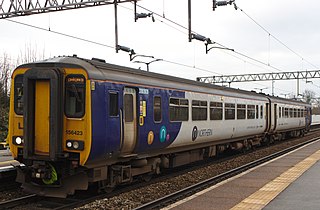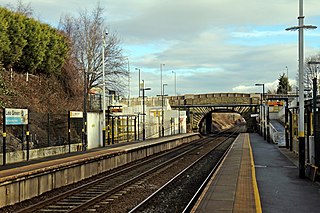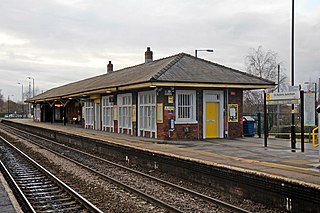Related Research Articles

The Liverpool and Manchester Railway (L&MR) was the first inter-city railway in the world. It opened on 15 September 1830 between the Lancashire towns of Liverpool and Manchester in England. It was also the first railway to rely exclusively on locomotives driven by steam power, with no horse-drawn traffic permitted at any time; the first to be entirely double track throughout its length; the first to have a true signalling system; the first to be fully timetabled; and the first to carry mail.

Earlestown railway station is a railway station in Earlestown, Merseyside, England, and one of the few "triangular" stations in Britain.

Edge Hill railway station is a railway station that serves the district of Edge Hill, Liverpool, England and is one of the oldest railway stations in the world
The North Union Railway was an early British railway company, operating in Lancashire. It was created in 1834, continuing independently until 1889.

There once were four direct railway routes between Liverpool and Manchester in the North West of England; only two remain, the two centre routes of the four. The most northerly and the most southerly of the four routes are no longer direct lines. Of the remaining two direct routes, the northern route of the two is fully electric, while the now southern route is a diesel-only line. The most northerly of the four has been split into two routes: the western section operated by Merseyrail electric trains and the eastern section by diesel trains, requiring passengers to change trains between the two cities. The fourth route, the most southerly of the four, has been largely abandoned east of Warrington; the remaining section caters mainly for freight trains.

Lea Green railway station is in St Helens, Merseyside, England, three miles south of the town centre near the suburb of Clock Face. The station is on the electrified northern route of the two Liverpool to Manchester lines, 10+3⁄4 miles (17 km) east of Liverpool Lime Street. Northern Trains operates the station with Merseytravel sponsorship displaying Merseyrail signs. Constructed in 2000, the station has a park and ride car park fitted with charging points for electrically-powered vehicles, a modern CCTV security system and a booking office at street level.

St Helens Junction railway station is a railway station serving St Helens, Merseyside, England. It is in Sutton, three miles southeast of St Helens town centre. The station is on the electrified northern route of the Liverpool to Manchester Line, 12 miles (19 km) east of Liverpool Lime Street. The station and all trains calling there are presently operated by Northern Trains.

Newton-le-Willows railway station is a railway station in the town of Newton-le-Willows, in the Metropolitan Borough of St Helens, and at the edge of the Merseytravel region. The station is branded Merseyrail. The station is situated on the northern route of the Liverpool to Manchester Line, the former Liverpool and Manchester Railway which opened in 1830. It is a busy feeder station for nearby towns which no longer have railway stations, such as Golborne, Billinge and Haydock. There is also a complimentary bus shuttle service to Haydock Park Racecourse on certain racedays.
There are various modes of transport available in Warrington.
Clayton Bridge railway station, Manchester, was a railway station that served the locality between 1846 and 1968.
Rainford Village railway station was on the railway line from St Helens to Rainford Junction, then Ormskirk, England.

Cheadle North railway station served the village of Cheadle, six miles south of Manchester. It was renamed from Cheadle to Cheadle North on 1 July 1950.

Astley was a railway station on the Liverpool and Manchester Railway on Chat Moss to the south of Astley village in what was then the county of Lancashire, England.

Broadheath (Altrincham) railway station served Broadheath and the northern part of Altrincham in Cheshire, England, between its opening in 1853 and closure in 1962.

Dunham Massey railway station was a station in England, serving the Dunham Massey. The station opened in 1854 and closed in 1962.

Heatley & Warburton railway station was located in Heatley near Warburton, Greater Manchester. It opened in 1853 and closed in 1962.
Golborne South railway station was one of two stations serving the town of Golborne, to the south of Wigan.

Lowton railway station served the village named Town of Lowton to the east of Newton-le-Willows and south of Golborne.

Bamfurlong railway station served the village of Bamfurlong part of Abram, to the south of Wigan.
The Kenyon and Leigh Junction Railway (K&LJR) was constructed to link the Bolton and Leigh Railway (B&LR), which terminated at the Leigh Branch of the Leeds and Liverpool Canal, with the Liverpool and Manchester Railway (L&MR) at Kenyon.
References
- Notes
- 1 2 Butt 1995 , p. 66
- ↑ Awdry 1990 , p. 78
- Bibliography
- Awdry, Christopher (1990), Encyclopedia of British Railway Companies, Patrick Stephens, ISBN 1-85260-049-7
- Butt, R.V.J. (1995), The Directory of Railway Stations, Patrick Stephens, ISBN 1-85260-508-1